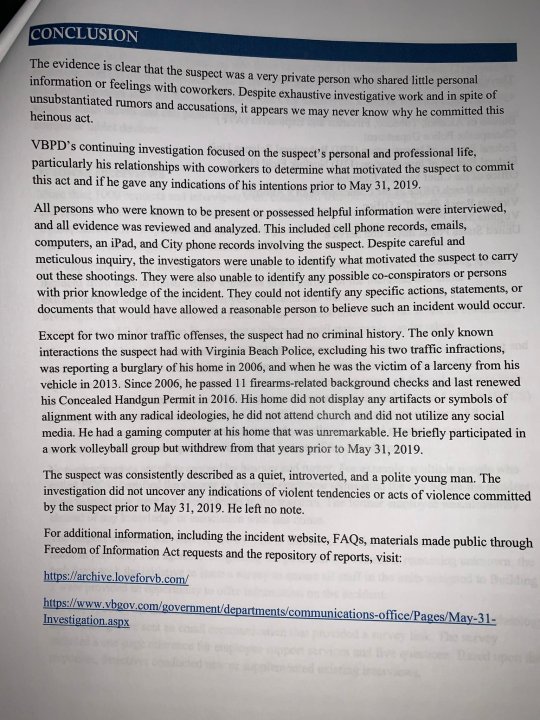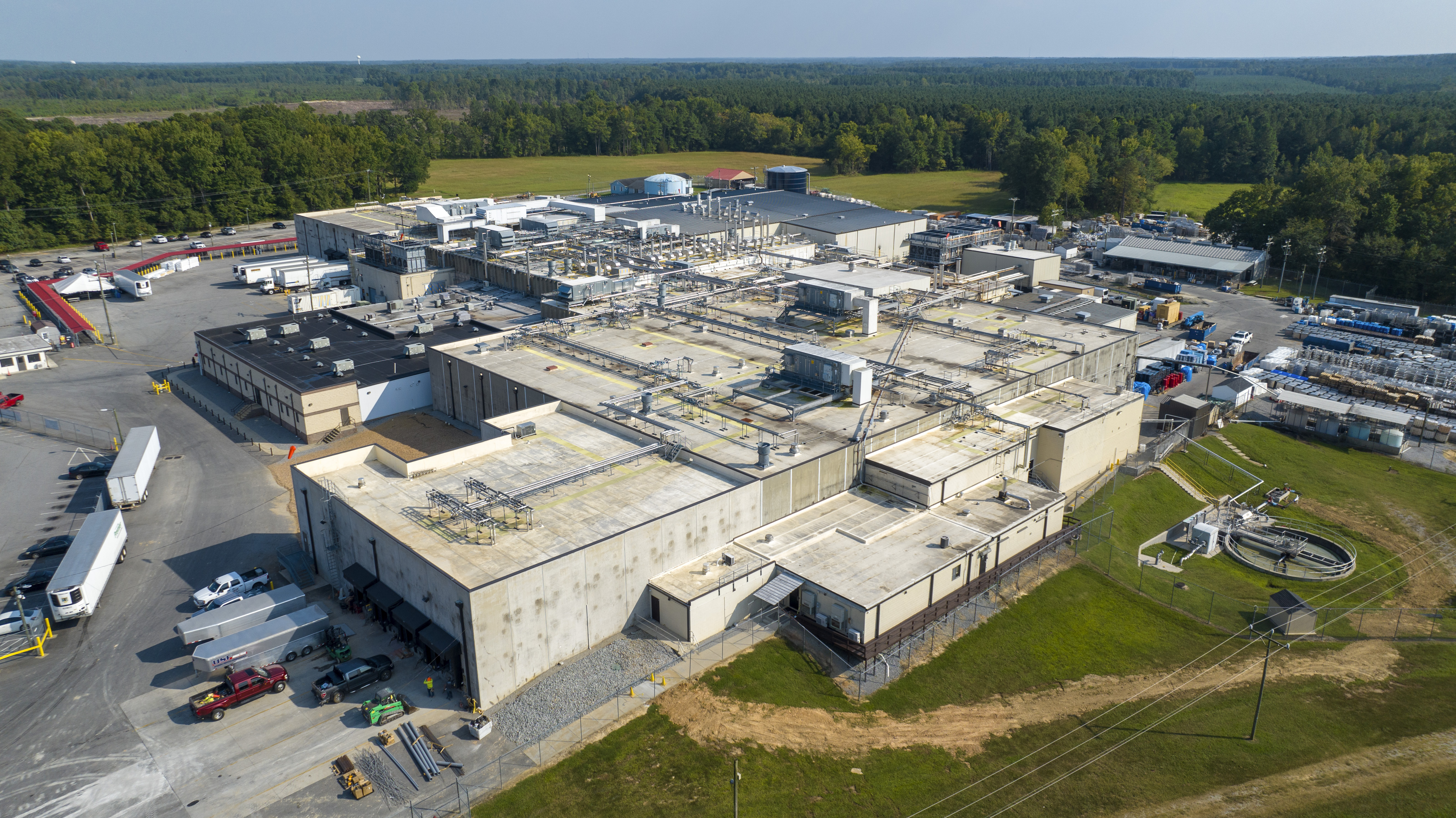VIRGINIA BEACH, Va. (WAVY) — Nearly two years after a city employee committed mass murder in city building, investigators have closed their investigation without answering the question: why did it all happen?
In a nearly 50-page report released Wednesday, the Virginia Beach Police Department concluded that “despite exhaustive investigative work and in spite of unsubstantiated rumors and accusations, it appears we may never why [the shooter] committed this heinous act.”
It was on May 31, 2019 that public utilities engineer DeWayne Craddock, 40, shot and killed 12 people and seriously hurt four others at Building 2 at the city’s Municipal Center before being killed himself in a gun battle with police.
Since then, the VBPD detectives conducted more than 1,000 contacts and interviews with individuals, analyzed over 10 terabytes of digital evidence and examined 504 pieces of physical evidence with help from the FBI.
No motive
Still, police don’t have much additional insight into why Craddock may have done what he did. The final summary recaps much of what was revealed nearly a year ago in VBPD’s interim report.
The report — which only names Craddock once, keeping with a pledge made by then-police chief Jim Cervera the night of the shooting — explains that Craddock was described as a “quiet, introverted, and a polite young man.”
“The evidence is clear that the suspect was a very private person who shared little personal information or feelings with coworkers,” the conclusion of the report reads.
Craddock worked nine years with the city and sent a resignation letter to his supervisor the morning of the shooting that simply stated he was resigning due to “personal reasons.”
Less than a year leading up to the shooting, Craddock received an employee evaluation that indicated “he did not meet the expectations of his job requirements.” As a result, he didn’t receive a merit pay raise that year.
As first revealed by the city’s independent investigation team, following that evaluation, Craddock wrote to his supervisor that “he was being placed at a different level of scrutiny than his peers.”
The report said the concern was specifically addressed by his supervisor in 2018 and Craddock was told that he had been making improvements and was given encouragement.
Closer to the shooting, Craddock again had to have interactions with management after a procurement issue arose. Current Police Chief Paul Neudigate said he could not just say Craddock was motivated to kill on account of what happened at work.
“We don’t deal in ‘likely’ and I think that is the problem,” Neudigate said. “We need specific facts and circumstances that guide us towards what is in this individual’s mind. It’s hard for police, it’s hard for anybody to tell you what is in your mind and what spurred your actions.”

Neudigate, who was working in Cincinnati at the time of the tragedy, said he can say with confidence no stone was left unturned to find a concrete “why” behind the shooting.
No manifesto was ever found, and Craddock acted alone.
The only place left to look is on an electronic tablet belonging to Craddock. It’s password protected and remains inaccessible after VBPD, Virginia State Police and the FBI were all unable to gain access.
“Is that the smoking gun, is it on that tablet?” Neudigate asked. “Five years down the road if they develop technology that could get us into that tablet, we are definitely going to resubmit the tablet and get in there because we are as curious as the community is about what is on there.”
Family speaks out
In a cover letter addressing Jason Nixon, the husband of shooting victim Kate Nixon, City Manager Patrick Duhaney said “while this report details the events of that day, unfortunately, no evidence was found that shed light on the shooter’s motivations.”
Duhaney acknowledged that for Nixon and families of the other victims “this is one of the most difficult findings to accept.” He says “investigators deliberately and methodically processed evidence, conducted interviews, ran tests, and tested theories” in the case.
“I think the report is garbage,” Nixon told 10 On Your Side. “It is the same thing that was back with the PowerPoint presentation. It’s exactly the same PowerPoint presentation.”
Nixon — who has been an outspoken critic of the city following the shooting — said the department should be ashamed that they haven’t found a motive.
Nixon says his wife, Kate, saw a different side of the shooter.
“She talked about him… that he was a psycho. That he had issues. That she didn’t like to be around him,” Nixon said.
Since Kate’s death, Nixon has been active in Richmond successfully lobbying the General Assembly on issues like under the Freedom of Information Act opening criminal investigative files relating to criminal investigations that are not ongoing. That would eventually include the May 31, 2019 mass shooting investigation.
“They should not have that power to tell me what I can see and what I can’t see. They gave me a summary of this,” Nixon said holding up the 36-page report summary Wednesday.
“I want to sit down and see the full report,” he said.
The bill about opening investigative files now awaits Gov. Ralph Northam’s signature.
In the meantime, Nixon says he wants back the possessions he lost to the investigation.
“I want my wife’s belongings back. I want her iPad back, I want my personal property back, they have had it for two years,” he said.
Nixon says he will sit down with Virginia Beach Police to ask questions about the investigative summary. He also pointed out there will be a few rules.
That meeting was originally scheduled for March 31, but has been postponed and rescheduled for April 14.
“I asked if I could bring an attorney and they said no. I asked who can I bring and they said two family members. I asked if this meeting is going to be recorded, and they said no,” he said.
The report summary released Wednesday also concludes there is no evidence from anyone interviewed that gave an indication the shooter was about to go on a rampage.
“Here is what we want. We want accountability. I want to make sure the Human Resources Department will be held accountable for actions or lack of actions of direct supervisors and that they will be held accountable,” Nixon said.
Nixon says other families feel the same way.
On a personal note, with only memories of a family united, now Nixon — almost two years later — lives in a void that sometimes consumes him.
We asked a simple question: how are you?
“I feel real empty. I feel like there is a void in my life, and I don’t know how to [fill] it,” he said.
Moving Forward
Duhaney, who also was not living in the city or leading it at the time of the shooting, said he has prioritized helping the healing process.
“Employers nowadays gotta be as vigilant as possible to ensure that if toxic environments identified that we take the right steps to root them out and correct it,” Duhaney said, acknowledging from what he has seen, no widespread toxic environment existed when the shooting occurred.
Still, he has recommended following through with recommendations from independent investigators.
Duhaney is hoping City Council agrees to hire six new employees to help centralize Human Resources in the city.
The Hillard Heintz report stated that the city’s current HR structure requires HR liaisons in certain departments to report to the manager of that department, creating perceived conflicts at times.
Moving forward, each city department would have its own HR coordinator reporting to the main HR department.
There is also funding included to continue counseling services for those most affected.
“I’m committed to putting the tools in place to help us become a better employer,” Duhaney said.










































































































